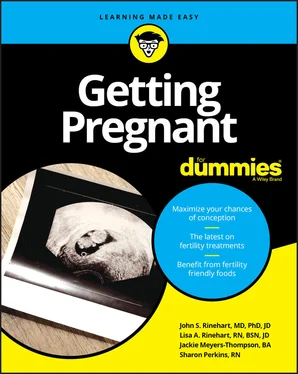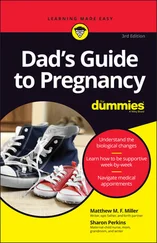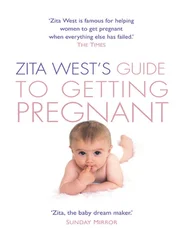Siblings take off the pressure that only children are sometimes subject to — the pressure to be all things to their parents, the total fulfillment of every pre-parent dream.
Siblings can teach each other valuable life lessons — as well as some not so valuable ones. Sibling influence isn’t always beneficial!
You just want another baby. There’s nothing wrong with that, as long as you remember that a new baby will, like the first, grow into an individual person with quirks and characteristics that may have you wondering why you thought this was a good idea in the first place.
Facing Secondary Infertility
Knowing what you’re dealing with, particularly if it is secondary infertility, doesn’t make it any easier. Often, if a woman had little to no problem conceiving a first or second child, the diagnosis of secondary infertility can be confusing. If there were problems the first time around, facing them again can be too much to bear. In the following sections, we discuss some of the different challenges that secondary infertility can present.
Wondering whether it will feel as bad as it did the first time?
Secondary infertility can be less stressful (you have a child), no different, or more stressful (you have a child who requires your time and efforts). Coping with secondary infertility after the stress of infertility sometimes seems unbearable. Perhaps you thought that despite the five years of trying to conceive baby number 1, baby number 2 would just miraculously appear one day. Sometimes that is the case, and conceiving and giving birth to number 1 seems to open the floodgates. More often than not, however, patterns tend to repeat themselves, including the pattern of primary infertility.
The obvious answer is to try the exact same plan that worked for you the first time after you have eliminated things which may have changed and introduced different barriers to pregnancy. If you want to try on your own, hoping for the possible reprieve from Infertility, Part 2, go ahead. But, for your peace of mind and for the sake of giving yourself the best opportunity within a reasonable amount of time, set some parameters. If you haven’t conceived naturally within six months to a year (less time if you’re over 40), consider going back to the drawing board and/or the original “architect,” whether that be your primary physician, OB/GYN, or reproductive endocrinologist.
Until you’ve given the tried and tested method another go-round, this probably isn’t the time to switch doctors, switch protocols, or go out on a brand-new limb. Give the old method at least a few tries before discussing moving to different options with your physician or before you discuss moving to a different physician with your partner.
 If it took fertility treatments to conceive, that does not automatically mean you need to return to the same treatment. Maybe less aggressive methods are needed for the second pregnancy.
If it took fertility treatments to conceive, that does not automatically mean you need to return to the same treatment. Maybe less aggressive methods are needed for the second pregnancy.
Dealing with disbelief: But it worked before …
Perhaps one of the most confusing physiological and psychological dilemmas occurs when something worked before and suddenly, apparently without reason, ceases to be effective.
Those struggling with secondary infertility commonly lament:
“We conceived the first month we tried.”
“All my husband had to do was look at me and we got pregnant with our first two.”
“Conceiving a child was never a problem with us.”
Sometimes secondary infertility seems to defy proper or satisfying explanations; other than being a year or two older than you were the last time you had a baby, nothing seems to have changed. Other times, getting to baby number one may have been a challenge, and the fact that it’s not going to be easier the second time around is disappointing, but not unexpected.
Begin with a careful review of your first successful go-round. Ask yourself the following:
Was it as easy as it seemed the first time or is that merely in comparison to the current struggle of secondary infertility?
Did you miscarry two or more times on the way to a healthy baby? Were these miscarriages investigated and found to be due to chromosomal abnormalities, which increase with age?
Was it ever suggested, prior to conception, that there might be issues that could cause a problem in conceiving or carrying a child (for example, abnormal hormonal levels; structural issues in the uterus, ovaries, or fallopian tubes; a family history of infertility; and so on)?
It’s not uncommon to disregard a previous observation, even if it was made by a medical professional, particularly if their diagnosis proved to be wrong, and the proof — the child — is now pulling all the pots and pans out of your cabinet and trying to flush them down the toilet. It’s even more common to ignore a family member’s recollection of history (for example, every woman on your mother’s side went into menopause at the age of 35) if you seem to be the exception.
Conduct your own investigation if you feel that you may have overlooked a comment or a speculation the first time around. Ask your partner if you can’t remember correctly or check with the physician whose care you were under prior to the conception of your first child. You may also see this as an opportunity to open or reopen discussion with family members to get an accurate picture of your genetic history when it comes to reproduction. You may well end up finding out that you do indeed have a clean bill of health, but you may also uncover information that can help you get to the bottom of secondary infertility.
Looking for What’s Different This Time Around
So, the reproductive system isn’t working like it used to — what could be the problem? Similar to primary infertility, finding the answer to secondary infertility can take a while and fill up at least an entire book such as this one. But, for the sake of getting to the point, we list some quick and perhaps not-so-obvious possibilities.
Unless (or even if) your last child was born six weeks ago, time does march on! And from an infertility point of view, that’s never a good thing. One of the primary reasons for secondary infertility is the age of the mother. But put this into perspective. If you had your first baby at 27 and now are trying for number 2 at 30, age is not the issue. However, if you had your previous child at age 38 and now you are 41, age becomes a major issue.
Age-related male infertility can also be a consideration, although Father Time does seem to be a bit more forgiving when it comes to the dads. Regardless of whose age we’re discussing, by definition, both you and your partner (should both parties remain the same!) will be older when you try to conceive your next child. As we have seen in preceding chapters, fertility declines throughout the years, so the baby that popped up so easily in your 20s may not be as forthcoming in your 30s or 40s. The longer the interval between children, the more likely that time is not on your side. The fact that you have conceived, carried, and delivered a baby are certainly positive predictors of your ability to do so, but realize that many cite the age of the mother as the primary reason for reproductive success. Is this true? Only time will tell.
 One interesting way to look at the effect on age is to look at the IVF data that the Society for Assisted Reproductive Technologies (SART) publishes. SART divides people using IVF into age-based categories. If you take the average delivery rates for each age category and graph them, they are almost a straight declining line. For the under-35 crowd, the average is about 45 percent per try. For the 45-and-over crowd, the average is 0. So for the ten years that this represents (35–45), there is a 45 percent drop, which because it is linear means that each year represents a 4.5 percent loss in fertility potential when using IVF. Based upon this logic, at age 38 your chance of a live birth using IVF is close to 20 percent per try, but by age 40 this has declined to 10 percent. So, in just two years your chance of success has been cut in half.
One interesting way to look at the effect on age is to look at the IVF data that the Society for Assisted Reproductive Technologies (SART) publishes. SART divides people using IVF into age-based categories. If you take the average delivery rates for each age category and graph them, they are almost a straight declining line. For the under-35 crowd, the average is about 45 percent per try. For the 45-and-over crowd, the average is 0. So for the ten years that this represents (35–45), there is a 45 percent drop, which because it is linear means that each year represents a 4.5 percent loss in fertility potential when using IVF. Based upon this logic, at age 38 your chance of a live birth using IVF is close to 20 percent per try, but by age 40 this has declined to 10 percent. So, in just two years your chance of success has been cut in half.
Читать дальше

 If it took fertility treatments to conceive, that does not automatically mean you need to return to the same treatment. Maybe less aggressive methods are needed for the second pregnancy.
If it took fertility treatments to conceive, that does not automatically mean you need to return to the same treatment. Maybe less aggressive methods are needed for the second pregnancy. One interesting way to look at the effect on age is to look at the IVF data that the Society for Assisted Reproductive Technologies (SART) publishes. SART divides people using IVF into age-based categories. If you take the average delivery rates for each age category and graph them, they are almost a straight declining line. For the under-35 crowd, the average is about 45 percent per try. For the 45-and-over crowd, the average is 0. So for the ten years that this represents (35–45), there is a 45 percent drop, which because it is linear means that each year represents a 4.5 percent loss in fertility potential when using IVF. Based upon this logic, at age 38 your chance of a live birth using IVF is close to 20 percent per try, but by age 40 this has declined to 10 percent. So, in just two years your chance of success has been cut in half.
One interesting way to look at the effect on age is to look at the IVF data that the Society for Assisted Reproductive Technologies (SART) publishes. SART divides people using IVF into age-based categories. If you take the average delivery rates for each age category and graph them, they are almost a straight declining line. For the under-35 crowd, the average is about 45 percent per try. For the 45-and-over crowd, the average is 0. So for the ten years that this represents (35–45), there is a 45 percent drop, which because it is linear means that each year represents a 4.5 percent loss in fertility potential when using IVF. Based upon this logic, at age 38 your chance of a live birth using IVF is close to 20 percent per try, but by age 40 this has declined to 10 percent. So, in just two years your chance of success has been cut in half.










